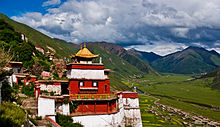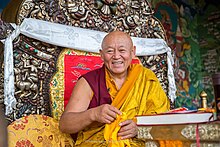|
Drikung Kagyu Drikung Kagyü or Drigung Kagyü (Wylie: 'bri-gung bka'-brgyud) is one of the eight "minor" lineages of the Kagyu school of Tibetan Buddhism. "Major" here refers to those Kagyü lineages founded by the immediate disciples of Gampopa (1079-1153), while "minor" refers to all the lineages founded by disciples of Gampopa's main disciple, Phagmo Drupa (1110-1170). One of these disciples, Jigten Sumgön (1143-1217), is the founder of Drikung. History  Like with all other Kagyu lineages, origins of Drikung Kagyü can be traced back to the Great Indian Master Tilopa who passed on his teachings to Mahasiddha Naropa who lived around 10th and 11th century. The founder of the Drikung Kagyü lineage was Jigten Sumgön (1143-1217) of the Kyura clan,[1] who was the disciple of Phagmo Drupa. According to historical account from the time, Jigten Sumgön's teachings attracted more than 100,000 people at a time, with the highest number of attendance recorded at 130,000.[2] Several sub-schools branched off from the Drikung Kagyü including the Lhapa or Lhanangpa Kagyü, founded by Nö Lhanangpa (Wylie: gnyos lha nang pa, 1164–1224) who came to Bhutan in 1194. This school was at one time important in Western Bhutan, particularly in the Thimphu and Paro regions, where they were rivals of the Drukpa Kagyü. The Lhapa first came into conflict with the early Drukpa teacher, Phajo Drugom Zhigpo (b. 12th century)[3] and finally with Ngawang Namgyal (1594–1651). In 1640 the remaining followers of the Lhapa Kagyü were expelled from Bhutan together with the Nenyingpa followers as both had sided with the attacking Tsangpa forces against the Drukpa during their three invasions of Bhutan and continued to refuse to acknowledge the authority of the Shabdrung.[4] Teaching and practiceThe unique doctrines of Drikung Kagyü as taught by its founder, Jigten Sumgön is preserved in the "Single Intention" or "One Thought" (Gongchig, Wylie: dgongs gcig)[5] and "The Essence of Mahāyāna Teachings" (Wylie: theg chen bstan pa'i snying po). According to Jampa MacKenzie Stewart, the Gonchik "recasts Buddhism in a fascinating and innovative form, emphasizing each aspect as being capable of revealing the full process of enlightenment."[6] The main practices of Drikung Kagyü are “The Five-fold Profound Path of Mahamudrā,” and “The Six Dharmas of Nāropa.” The five-fold Mahamudrā, also known as the "possessing five", consists of five elements:[7]
This practice is traditionally cultivated in retreat alongside the Six Dharmas of Naropa, and it is preceded by the preliminary practices called ngondro.[8] This presentation is outlined in Clarifying the Jewel Rosary of the Profound Five-Fold Path by Kunga Rinchen, the Dharma heir to Jigten Sumgön. The Drikung Kagyü also have a tradition of Dzogchen teachings, the Yangzab Dzogchen.[9] It is based on termas revealed by the Drikung Tertön (hidden treasure revealer), Rinchen Phuntsog in the sixteenth century. PhowaThe Drikung lineage is popularly known for its development of the practice of Phowa, in which a practitioner learns how to expel his/her consciousness or mindstream through the posterior fontanelle at the top of the skull at the moment of death. One of the Six Yogas of Naropa, this practice is said to aid the practitioner in remaining aware through the death experience, thus aiding one in attaining enlightenment in the Bardo (the state in between death and the next rebirth) or in achieving a birth conducive to the practice of Dharma. Monasteries and centers The first and main Drikung Kagyü monastery is Drikung Thil Monastery,[10] founded in 1179[10] by Jigten Sumgön[10] approximately 150 kilometers northeast of Lhasa. Aside from the Drikung Valley in Ü, the Drikung Kagyu has a strong presence in Nangqên County in what was Kham, in western Tibet (including Kailash), and in Ladakh. Tsari and Lapchi - two important sacred sites for all Tibetan Buddhists - also have a strong Drikung Kagyu presence. Among the so-called "four major and eight minor" Kagyu lineages, Drikung Kagyu is one of four Kagyu lineages that continue to exist as independent institutions (the other three being the Karma Kagyu, Drukpa Lineage and Taklung Kagyu). Outside of Tibet, the headquarters for the tradition in exile is Jangchubling, located in Dhera Dun, in the Indian state of Uttarakhand.[11] Drikung Kagyu is one of the most prominent lineages in Ladakh where its main monasteries are Phyang and Lamayuru, with roughly 50 other monasteries spread across Ladakh region. A series of Drikung Dharma centers were also founded in the West, a project begun by Drikung Kyabgon Chetsang Rinpoche in 1978.[12] Lineage notesSpiritual heads
From the founding of Drikung Thil Monastery in 1179 to the present day, the Drikung Kagyü lineage has been led by a succession of spiritual heads ("throne-holders"). One of the two current heads of the lineage, Drikung Kyabgön Chetsang Rinpoche,[13][14] Könchok Tenzin Kunzang Thinley Lhundrup (b. 1946),[15] the 37th Drikungpa resides at Drikung Kagyü Institute at Dehra Dun, India.[14] The other head of the Drikung Kagyü Lineage, the 36th Drikungpa, Drikung Kyabgön Chungtsang Rinpoche, Könchok Tenzin Chökyi Nangwa (b. 1942) lives in Lhasa, Tibet.[16] Female protectorAnother unique feature of the Drikung lineage is its female dharmapāla, Achi Chokyi Drolma. The great-grandmother of Jigten Sumgön,[17] she prophesied his birth and vowed to protect those in his lineage. She is unusual in that she is both a female protector and an enlightened bodhisattva that can be taken as an iṣṭadevatā in meditation practice. She is depicted either sitting on a horse or standing with a kapala in her left hand and a mirror in her right hand.[18] Achi's practice became so popular that she has been included in other lineages, such as the Karma Kagyu. First nunIn 2002 Khenmo Drolma, an American woman, became the first bhikkhuni (a fully ordained Buddhist nun) in the Drikung Kagyü lineage. She is also the first westerner, male or female, to be installed as an abbot in the Drikung Kagyü lineage, having been installed as the abbot of the Vajra Dakini Nunnery (America's first Tibetan Buddhist nunnery, located in Vermont) in 2004.[19] Lineage timeline
References
Further reading
External links |
